UAVs And Electronic Payloads: Navigating Turbulent Times, Bright Skies Ahead

As seen in Electronic Military & Defense magazine.
By Paul Kruczkowski, Editor
The unmanned aerial vehicle (UAV) market is alive and well, despite worldwide economic worries and concerns about deep U.S. defense budget cuts. Although the tremendous growth the industry has experienced in recent years may slow temporarily, analysts still predict great things for UAVs over the next decade and see the sector as one of the best opportunities for electronic design and manufacturing in the defense industry.
In this article, we will first discuss the overall prospects for the UAV market. We will then explore some of the important UAV electronic payload categories, the projections for the payload market, and a recent design trend that has the potential to transform the UAV electronic payload industry. Next, we will take a look at the major UAV programs — and the electronic payloads they carry — that are shaping this rapidly evolving market. Finally, we will take a glimpse at several emerging UAV programs that may drive the electronic payload market going forward.
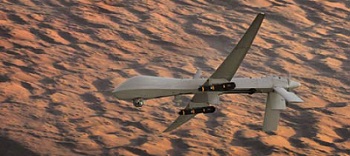
U.S. Air Force MQ-1 Predator unmanned aircraft, armed with AGM-114 Hellfire missiles
The UAV Market
Market analysts remain bullish on the potential of the UAV market. For instance, the Teal Group projects worldwide UAV spending to nearly double over the next decade, from $6.6 billion in 2012 to $11.4 billion in 2021, totaling just over $89 billion in the next 10 years. It is abundantly clear that intelligence, surveillance, and reconnaissance (ISR) is the cornerstone of the global war on terror, and that the UAV has proven itself to be very adept at ISR. Military and civilian authorities around the world have observed the capabilities and versatility of the UAV and will continue to expand their use of unmanned vehicles.
The Teal Group also predicts the U.S. will account for approximately 62% of the worldwide RDT&E (research, development, test, and evaluation) for UAVs and 55% of the procurement of these systems. The Asia-Pacific region will be the second largest market, followed by Europe as a close third. The U.S. defense budget still has $3.8 billion earmarked for UAV spending in FY2013, even with a 12.2% reduction in overall aircraft funding.
Electronic Payloads
Today’s UAVs carry a wide range of electronic payloads on ISR missions. Sometimes these payloads are mounted within the vehicle, but in other cases multiple sensors are combined into payload suites that can be mounted within stabilized multi-axis gimbal systems to provide wide angles of coverage. Major categories of UAV electronic payloads include:
- Electro-optic (EO) cameras provide near real-time high-definition video surveillance in the visible light spectrum.
- Infrared (IR) sensors operate in a wide range of frequencies, from long-wave (LWIR) to short¬wave (SWIR), and are used for thermal imaging of people and vehicles, providing photograph-like images of objects in the field of view, and detecting targets by their chemical signature in addition to their visual appearance.
- Lasers provide luminance for night vision and designators for munitions targeting.
- Synthetic aperture radar (SAR) utilizes a single antenna and time-multiplexing of radar returns to create accurate radar imaging to target area.
- Signal intelligence (SIGINT) sensor payloads detect, locate, and classify RF transmissions, allowing forces to monitor or interrupt enemy communications
- Electronic support measures (ESM) are electronic warefare (EW) payloads that detect, locate, and classify radar emitters, providing early warning so that radar sources can be disabled.
- Command, control, communications, computers, and intelligence (C4I) systems aboard UAVs or in ground control units allow collected video, data, or targeting information to be coordinated and disseminated throughout the ISR network.
The market for UAV payloads was worth $2.7 billion in FY2012 and is forecasted to increase to $6 billion in FY2021 by the Teal Group. While the overall UAV electronic payload market is projected to have steady growth over the next decade, the SIGINT / EW payload market is expected to see a massive 20.2% compound annual growth rate (CAGR) from FY2012 to FY2017. UAV system upgrades involving smaller, lighter, and higher-performance payloads, as well as the stocking of extra payloads for field changes and repairs, should allow growth of the payload market to outpace the vehicle market.
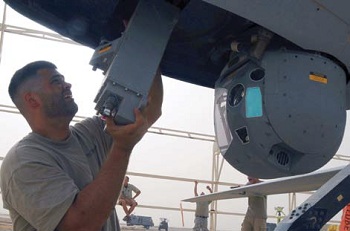
Replacing part of the multispectral targeting system ball on a MQ-1B Predator
Another trend that could have a major impact on the growth of the UAV payload market is open architecture design. An emerging design philosophy in the defense industry, open architecture recently demonstrated its applicability to UAV programs. General Atomics Aeronautical Systems, Inc. (GA-ASI), manufacturer of MQ-9 Reaper, collaborated with SELEX Galileo and Cobham Aviation Services to integrate SELEX Galileo’s active electronically scanned array (AESA) radar and other sensors onto an MQ-9 Reaper — the first step in proving the concept of the new platform and sensor-agnostic skyISTAR mission management system, allowing customers the flexibility to integrate future payload capabilities into the system. If this open payload architecture approach develops into a widespread UAV design trend, it would further enhance the opportunities for payload manufacturers not specified into the initial UAV designs.
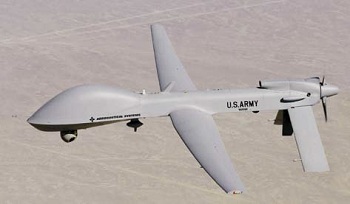
U.S. Army MQ-1C Grey Eagle
Major UAV Systems And Their Electronic Payloads
The UAV systems operated by the U.S. Department of Defense (DoD) are diverse in configuration and mission. High-altitude, long-endurance (HALE) UAVs like the RQ-4 Global Hawk are at the top of line in terms of size and cost (at approximately $220 million each) and were designed to replace the high-altitude U-2 Dragon spy plane, which has been in service since 1955. Medium-altitude, long-endurance (MALE) UAVs like the MQ-9 Reaper fly lower and slower than the HALE UAVs but also carry payloads with precision hunt and kill capabilities. These two classes of UAVs will receive the majority of DoD spending on unmanned aerial systems. However, small tactical unmanned aerial vehicles (STUAVs) — used by ground troops to gain advantage in battlefield awareness — are less expensive platforms purchased in much larger quantities, and so provide another substantial market opportunity for payload manufacturers.
HALE UAVs: Global Hawk
Hawk hit some turbulence when the FY2013 budget canceled the Block 30 program and provided no funds to operate the 18 UAVs in service, which would effectively eliminate the U-2’s planned replacement in 2015. The House Armed Services Committee tried to preserve this ISR capability by designating $260 million of its markup in the National Defense Authorization Act for FY2013; however, their counterparts in the Senate disagreed, so the future of the program is in question.
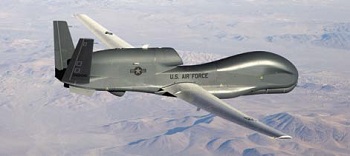
U.S. Air Force RQ-4 Global Hawk
Good news for the Global Hawk platform came in the form of a $1.7 billion contract for five Block 40 Global Hawks for the NATO Alliance Ground Surveillance (AGS) aircraft program and $657.5 million in the FY2013 budget for the U.S. Navy Broad Area Maritime Surveillance Demonstration (BAMS-D) program, which consists of five Global Hawks that the U.S. Navy acquired from the U.S. Air Force as a test platform for the development of the MQ-4C UAV. Initial operational capability (IOC) for the NATO AGS is projected for 2014, and the first MQ-4C BAMS was scheduled for June 2012 delivery with IOC expected in 2015.
In terms of payload, RQ-4 Block 40 incorporates the BAN/ZPY-2 MP-RTIP (Multi-Platform Radar Technology Insertion Program), which uses AESA technology to deliver long-range, very high-resolution SAR images, ground moving target indicator (GMTI), and new air target tracking capabilities. The RQ-4 will communicate through wideband Ku SATCOM and line-of-sight connectivity. A future battle management and control (BMC2) system will direct weapons to attack stationary and moving targets using the Global Hawk’s radar cues from its SAR and GMTI radars.
The MQ-4C BAMS UAV sensor payload provides ISR and tactical information over a mission radius of 2,000 nautical miles (nm) and will leverage several advanced technologies to accomplish this mission. The Multifunction Active Sensor Active Electronically Scanned Array (MFAS AESA) radar provides long-range detection and identification of targets. The MQ-4C will also have the Multi-Spectral Targeting System (MTS¬B), which integrates an EO camera, IR sensors, a laser illuminator, and a laser range finder/designator to provide auto-target tracking and high-resolution, full-motion video. In addition, the BAMS will have AN/ ZLQ-1 electronic support measures (EMSs), giving it the capability for specific emitter identification (SEI), and an automatic identification system (AIS) that provides maritime vessel movement information from VHF broadcasts. Finally, the MQ-4C is specified to have radar capabilities for maintaining safe separation from other airborne assets.
MALE UAVs: Predator/Reaper/Grey Eagle
The MQ-9 Reaper MALE UAV continues to build on the reputation of its predecessor, the MQ-1 Predator, and is the clear choice of the U.S. Air Force for long-endurance UAVs with strike capability. The Air Force spent most of the money earmarked for UAV spending in FY2012 to procure 48 MQ-9 Reapers, and although the quantity of Reapers is reduced to 24 for FY2013, the budget still has $885.4 million for the procurement of the MQ-9. The FY2013 budget also provides $749.6 million to continue deployment of the U.S. Army MQ -1C Grey Eagle, a variant in the predator family. The strategic goal is to procure enough UAVs and ground stations to support 65 combat action patrols (CAPs) by FY2017.
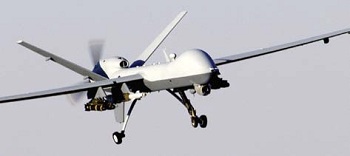
U.S. Air Force MQ-9 Reaper
In addition to its SIGINT payload, data links, and beyond-line-of-sight communications equipment, the Reaper boasts the Raytheon AN/DAS-1 MTS-B Multi-Spectral Targeting System, which integrates an EO camera and IR sensors, a laser illuminator, and a laser range finder/designator. MTS-B is capable of full-motion video, day or night, and provides the tracking and targeting required for precision laser-guided munitions.
The Reaper also carries the AN/APY-8 Lynx II radar, an all-weather SAR with GMTI technology. The Ku-band radar has a “search” mode with a range of 47 nm with a resolution of 10 feet, a “stripmap” mode that covers 29 nm with 1-foot resolution, and a “spotlight” mode that produces photograph-like radar images that cover 21 nm with a resolution of 4 inches.
MQ-1C Grey Eagle has communication relay payloads and EO/IR video sensors. It also uses an AN/ZPY-1 STARLite small tactical SAR that has GMTI and dismount moving target indicator (DMTI) functionality to provide all-weather, wide-area surveillance and detection of stationary, dismounted, and moving targets.
STUAVs
This class of UAVs is on the other end of the spectrum from the Global Hawk and Reaper. STUAVs are small enough for a soldier to carry in a backpack along with a handheld control unit. They typically sacrifice endurance, payload capacity, altitude, range, and strike capability in favor of light weight, portability, quick deployment, and real-time ISR and targeting information. These UAVs essentially become an extension of the soldier, hand-launched to provide a bird’s eye view of the battlefield and tactical ISR support of combat battalion and below operations.
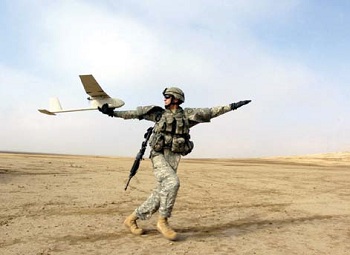
U.S. Army RQ-11 Raven
There are several STUAV manufacturers, but one company in particular — AeroVironment — has been very successful at getting qualified by the various branches of the U.S. armed forces. In fact, the U.S. Marine Corps has adopted four different AeroVironment UAV systems. The company also has received a $2.5 million order from the U.S. Air Force for its Wasp AE, and orders totaling $28.3 million from the Army, Marines, and Air Force for its new RQ-20A Puma AE. The DOD FY2013 budget also has $25.8 million designated for the procurement of 234 AeroVironment RQ-11 Raven systems. The Raven, Wasp AE, and Puma AE are interoperable, using the same ground control system (GCS). Additional details on these STUAVs and their payloads are as follows:
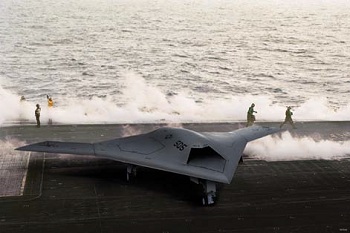
X-47B, the demonstration version of the U.S. Navy MQ-47B
- The 4.2-lb. RQ-11 Raven has forward- and side-looking EO/IR cameras for day and night video capture. The Raven is remotely operated or can be programed for autonomous flight.
- The Wasp AE weighs only 2.8 lbs. and is capable of encrypted communication beyond line-of-sight and can provide video, voice, data, and text relay. It carries the Mantis i22 AE gimbaled payload, which only weighs 9.7 ounces, delivers front- and side-looking color and IR video. It was designed for land and water landing, so it can operate in harsh environments.
- An RQ -20A Puma AE system consists of three UAVs and two GCS. The vehicles weigh 13 lbs. each and are battery powered with 2-hour endurance. The UAV has a stabilized gimbal, is equipped with an EO/IR video camera and IR illu¬minator, and is capable of tilt and pan of plus or minus 180 degrees, giving it 360-degree coverage. It is designed for enhanced survivability for both maritime and land environments and operates in foul weather conditions and over rough terrain.
Looking To The Future
The U.S. Navy is working diligently to get the MQ-47B into service as soon as possible, its 2,500-km range provides a greater standoff distance between the target and the aircraft carrier from which it was launched, and it eliminates the issue of pilot endurance. It can carry 4,500 lbs. of smart bombs, and its projected cost is about half that of a new $100 million (manned) F-35 Lightning II JSF. Its first carrier launch and recovery is scheduled for 2013, followed by autonomous aerial refueling demonstration in 2014, with the goal of bringing the platform into service by 2018. It is likely to carry EO/IR sensor payloads, SAR and ISAR radar with GMTI and MMTI, as well as electronic support measures (ESMs).
There are other emerging UAV programs that could provide great opportunities for the electronic payload market, including:
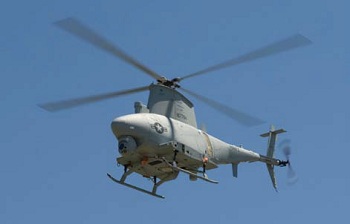
U.S. Navy MQ-8B Fire Scout
- MQ-8C Fire Scout: Northrop Grumman received a $263 million contract for eight new MQ-8C Fire Scout unmanned helicopters, based on the Bell 407 airframe. This new UAV is twice the size of the current MQ-8B, which will allow it to carry 1,000 lbs. of payload (weapons and sensors) — five times the capacity of the current Fire Scout.
- Solar Eagle: The Solar Eagle is a HALE UAV being built by Boeing Defense, Space & Security under a Defense Advanced Research Projects Agency (DARPA) program. This solar-powered UAV will be able to carry 1,000 lbs. of ISR payload at 60,000 feet for five years without replenishing.
- ScanEagle: The ScanEagle UAV has been tested with a hydrogen fuel cell, which would reduce the UAV’s power plant weight, allowing for greater IRS payloads.
- Argus One: This lighter than air (LTA) UAV has a flexible, non-rigid body that can be easily stored, transported, and deployed. It is designed to carry about 30 lbs. of sensors for ISR and communications, permitting GPS-guided autonomous flight.
Conclusion
In this article, we have reviewed only a portion of the current and future UAV systems that will provide opportunities to the electronic payload market, both domestically and abroad. The growing need for ISR capabilities will only increase the market opportunities for UAV systems and electronic payloads, despite shrinking defense budgets and austerity measures worldwide. In today’s budget-conscious world, better-equipped soldiers provide a sensible path to reducing the size of the military without decreasing its effectiveness, and UAVs and their payloads will play a significant role in achieving this goal. (Although it was not the focus of this article, there is also a growing law enforcement and civilian market for UAVs that will provide additional opportunities and support industry growth in the next decade.)
The design trends for future UAV systems will focus on increasing range, endurance, complexity, and autonomy. Some of these will be achieved through the capabilities of the vehicles themselves, but likely more will be accomplished through more sophisticated payloads, such as wide-angle EO/IR sensors and advanced radar systems that can penetrate foliage. The STUAV payloads market will continue to focus on size, weight, and power (SWaP) and will look to add large UAV capabilities including SIGINT, SAR, and hunt and strike capabilities. Technical issues like sensor drift will present challenges as complex non-EO sensors are developed for increasingly smaller UAVs. The electronic payload industry will have ample opportunity to innovate and further improve the performance of UAV systems. As creative ways are developed to expand the roles of these platforms, the blue skies ahead should become increasingly crowded with UAVs.
